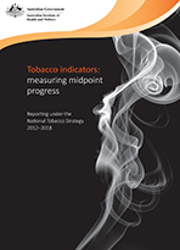Summary
This report presents progress against the outcome indicators (indicators 1–8ii) listed under Part Seven of the National Tobacco Strategy 2012–2018 (NTS) and an additional six indicators (indicators 9–14) agreed to during the development of the reporting framework (see Chapter 1 of this report). The indicators are organised across five smoking phases: exposure, uptake, transition, established smoker and cessation. This report will assist the Australian Government, states and territories in monitoring progress towards achieving the objectives and targets of the NTS and the National Healthcare Agreement (NHA) benchmarks.
Most indicators show favourable progress
- Fewer people were exposed to tobacco smoke at the midpoint than at baseline, indicating positive progress for the outcome indicators in the exposure smoking phase:
- 40% decline among households with dependent children and non-smoking adults exposed to tobacco smoke inside the home daily.
- Positive progress was also made against the uptake smoking phase indicators, with fewer secondary school students (aged 12–17) and adults trying cigarettes for the first time. In addition, young people delayed the onset of tobacco smoking, with an older average age reported at midpoint than at baseline.
- Favourable trends were seen in the transition phase indicators:
- over a 20% decline in the proportion of secondary student and young adults (aged 18–24) smoking at least 100 cigarettes in their lifetime.
- Fewer adults and secondary students reported established patterns of smoking at the midpoint than at baseline:
- regular smoking among secondary students (weekly smoking) and adults (daily smoking) declined by almost a quarter.
- The trends for cessation were less clear, with difficulty in assessing progress between baseline and midpoint for quit attempts or average age at cessation, but a significant increase in the proportion of ever-smokers quitting for 12 months or more. A longer time series is necessary to monitor progress for cessation.
Some groups achieved greater progress than others
There are two different measures to evaluate the gap between two population groups: the rate ratio and the rate difference. In this report, the rate ratio has been used as the main measure to analyse the gap between population groups. When drawing conclusions about changes in smoking related measures between population groups over time, both rate differences and rate ratios are important considerations. Further information is provided in Box 3.2 on page 72.
- Findings in this report show people living in Inner regional areas and students living in Outer regional areas made significant progress across numerous indicators.
- Findings in this report also show that inequalities within particular population groups increased for some indicators.
- Daily smoking rates significantly improved across all socioeconomic areas but the improvement was proportionally greater for those living in the highest two socioeconomic areas.
Summary data for the indicators is provided in Table S1. Different data sources and varying time points are used in this table. Trends across indicators and smoking phases should therefore be treated with caution.
Indicators 3 and 8i in Table S1 also relate to the NHA (of 2008 and updated in 2012) benchmark: ‘By 2018, reduce the national smoking rate to 10 per cent of the population and halve the Indigenous smoking rate, over the 2009 baseline’.



